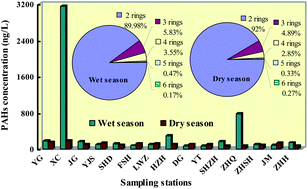The Pearl River Delta (PRD) region is one of the most population-dense areas in China. The safety of its drinking source water is essential to human health. Polycyclic aromatic hydrocarbons (PAHs) have attracted attention from the scientific community and the general public due to their toxicity and wide distribution in the global environment. In this work, PAHs pollution levels from the drinking source water in nine main cities within the PRD were investigated. ∑15 PAHs concentrations during the wet season varied from 32.0 to 754.8 ng L−1 in the dissolved phase, and from 13.4 to 3017.8 ng L−1 in the particulate phase. During the dry season, dissolved PAHs ranged from 48.1 to 113.6 ng L−1, and particulate PAHs from 8.6 to 69.6 ng L−1. Overall, ∑15 PAHs concentrations were extremely high in the XC and ZHQ stations during the wet season in 2008 and 2009. In most sites, PAHs originated from mixed sources. Hazard ratios based on non-cancerous and cancerous risks were extremely higher in XC compared with the others during the wet season, though they were much less than 1. Nevertheless, risks caused by the combined toxicity of ∑15 PAHs and other organics should be seriously considered. PAHs toxic equivalent quantities ranged from 0.508 to 177.077 ng L−1.

You have access to this article
 Please wait while we load your content...
Something went wrong. Try again?
Please wait while we load your content...
Something went wrong. Try again?


 Please wait while we load your content...
Please wait while we load your content...